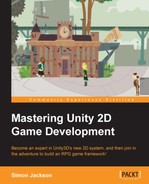Book Description
Become an expert in Unity3D's new 2D system, and then join in the adventure to build an RPG game framework!
In Detail
Unity3D has long been seen as a massive 3D game-making middleware system, with lots of power and an easy-to-use editor. Now, with 2D games back in fashion, Unity has created a 2D toolset for developers with the know-how to create great games.
If you are looking for a book that will show you how to make a fully functional, customizable RPG game end to end, then this is the book for you. You will learn how to build an RPG game framework, learning lots of tips and tricks along the way, from advanced C# scripting to getting the most out of Unity's built in features such as Mecanim and curves in ways you may have not even considered.
By the end of this book, you will be able to architect, create, deploy, and integrate your game with all of your intended platforms, and have the knowledge to build and customize the Unity editor for the games you create with confidence. You will also be tooled with tricks from the trade on marketing, monetization, targeting as many platforms as possible, with a keen focus on how to best profit from your title.
What You Will Learn
- Explore the new features introduced in Unity3D 4.3 by building your own RPG game
- Delve into the new sprite importing and rendering system
- Master the best parts of the new Sprite animation system and improved Mecanim features
- Make the most of your rendering with tags, layers, sprite sorting, and ordering
- Dissect the proper use of Delegates, Events, and Messaging, including tips and tricks, and build a full RPG conversation system
- Do battle with Mecanim-based AI and state machines
- Build for success with tips on marketing, monetization, and deployment
- Drive home the platform of choice and expand into deployment/editor extensions
Downloading the example code for this book. You can download the example code files for all Packt books you have purchased from your account at http://www.PacktPub.com. If you purchased this book elsewhere, you can visit http://www.PacktPub.com/support and register to have the files e-mailed directly to you.
Table of Contents
- Mastering Unity 2D Game Development
- Table of Contents
- Mastering Unity 2D Game Development
- Credits
- About the Author
- Acknowledgments
- About the Reviewers
- www.PacktPub.com
- Preface
- 1. Overview
- 2. Building a Character
- 3. Getting Animated
- 4. The Game World
- 5. NPCs and Interactions
- 6. The Big Wild World
- 7. Encountering Enemies and Running Away
- 8. Shopping for Weapons
- 9. Getting Ready to Fight
- 10. Fight and Gain XP
- Proving ground
- Leveling up
- Balancing
- Putting it together
- Preparing the BattleManager script
- Beefing up the enemy
- Selecting a target
- Attack! Attack!
- The pesky Goblin reacts with 3D particles
- Mixing up 2D and 3D
- Particle effects and 2D
- Adding the deathly sprites
- Creating the material for the particle effect
- Restructuring the Goblin prefab
- Adding the particles
- The death animation
- Adding particles to the animation
- Connecting the dots
- Making the new GoblinEnemy game object a prefab and adding it to the battle
- Houston, we have a problem!
- The final run-through
- Going further
- Summary
- 11. Onward Wary Traveler
- 12. Deployment and Beyond
- A. Additional Resources
- Index
